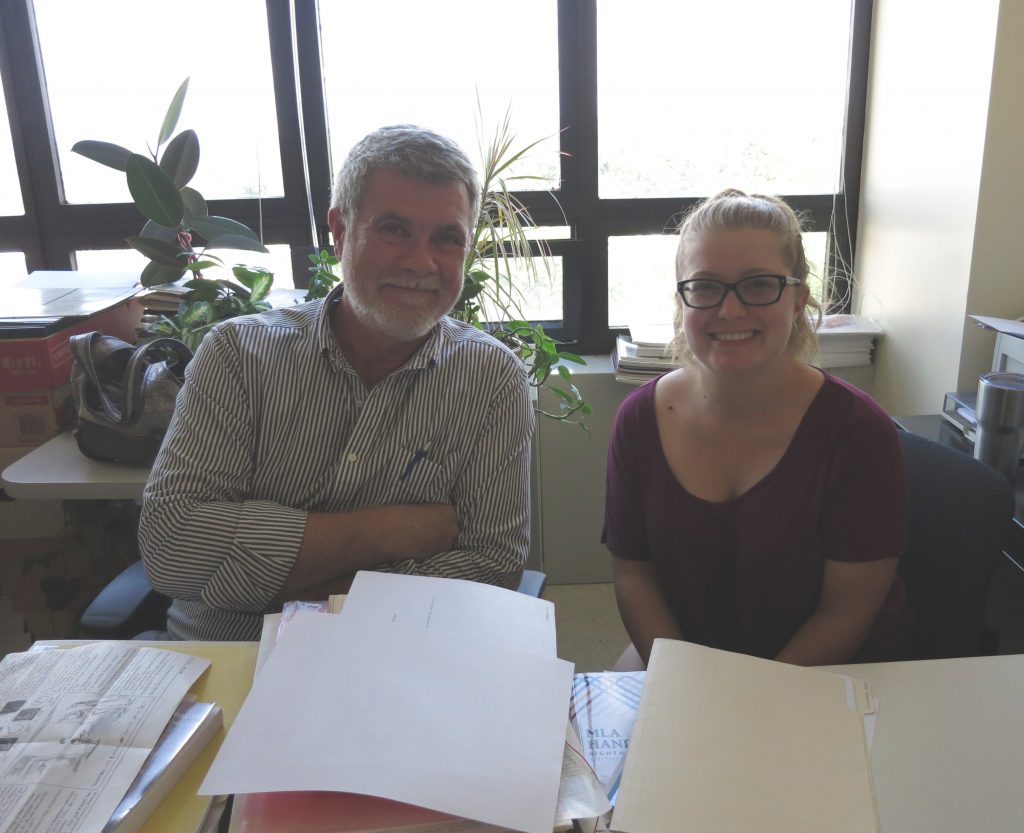Exploring Shakespeare’s Influences
In her junior year, Jahna Romano sat in the front row of Thomas Olsen’s Shakespeare course. She asked insightful questions and took detailed notes. Olsen, an associate professor of English, recognized in Romano a fellow Shakespearean.
When he needed help completing a book project on the stories that inspired the Bard’s plays, Olsen tapped Romano as a research assistant. Now in the third and final semester of their collaboration, Olsen and Romano ’17 (Secondary Education – English) have made steady progress on a book that Olsen described as the first student-friendly collection of Shakespeare’s source stories attempted in over five decades.
Shakespeare penned nearly 40 plays, almost all of which were based on an existing story or stories. Olsen’s book examines the source material of seven Shakespeare plays: Hamlet, King Lear, The Merchant of Venice, Othello, Much Ado About Nothing, and Romeo and Juliet. Olsen selected popular plays that are frequently taught and lend themselves to comparison to a single source story.
Olsen obtained funding through the College of Liberal Arts and Sciences’ Faculty Research Support Initiative to pay Romano to assist him with the “very precise and sometimes tedious tasks” of scholarly editing. Because Romano is a college student, a target audience for Olsen’s book, her feedback proved invaluable.
“I’ve had a few such arrangements in the past,” said Olsen of his prior research assistantships, “but this by far has been the most helpful….The ultimate outcome of this book is directed at people like Jahna, so she’s doubly helpful by being a model, whereas a lot of faculty scholarship is going to end up to a much narrower, scholarly audience, and therefore it’s a lot harder for an undergrad or even a grad student to understand what that is. This has been from the beginning intended as a popular book for intelligent readers and upper-division students, as opposed to a journal article for just a few specialists.”
As she read through the manuscripts, Romano highlighted unfamiliar words and references, and discussed her notes with Olsen during their biweekly meetings. She frequently conducted her own research for glosses and footnotes, consulting resources like the Oxford English Dictionary (OED), which lists definitions and illustrations of word usage from various periods in history.
“I never used the Oxford English Dictionary before in my life, and now I use it all the time,” said Romano. “Anything that I don’t understand or I can’t find, I’ll look up in the OED, and it’s always fun to see where the word came from and how old it is.”
Romano familiarized herself with Shakespeare’s plays and offered comments on Olsen’s introductions, which often triggered another round of edits. “She was my first test,” noted Olsen. “At the beginning of each story, I wrote a 1,200-2,000 word introduction that captured what was important, but if Jahna said, ‘I don’t understand this,’ or ‘I’d like to hear more,’ that was a signal to me that I would edit.”
Perhaps Romano’s most valuable contribution was her work in converting thousands of sixteenth- and early seventeenth-century words into modern spelling. For example, spelling conventions during the period did not distinguish between y’s and i’s, so Romano updated words like “inclyne” and “fyne” to “incline” and “fine,” and impressed Olsen with her proficiency.
“It’s mostly just practice,” Romano explained. “As you read through the manuscripts more, you recognize similar words and similar spellings. A lot of things would crop up over and over again.”
Romano described her work, which required hours of staring at copies of typescripts from 400-year-old printings, as “really arduous at times,” but also rewarding. “It is a slow process but it’s a process that takes a lot of concentration, and that’s helpful and useful for other assignments. It is important to have that level of scholarship because you can give that type of focus to your other academic pursuits,” Romano said.
Her work on this project should serve her well in her career as a secondary education teacher. Romano, who was once discouraged by a teacher from reading for the part of Lady Macbeth because she “didn’t have a mean bone in [her] body,” hopes to teach her students that “Shakespeare can be fun.”
Romano, Olsen suggested, could deploy some of their research in her own work as a Shakespeare teacher. Romano responded, “I’ll use the book in my classroom – how about that?”
Above photo: Thomas Olsen, an associate professor of English, and student research assistant Jahna Romano have worked for three semesters editing Olsen’s student-friendly collection of Shakespeare’s source stories.

